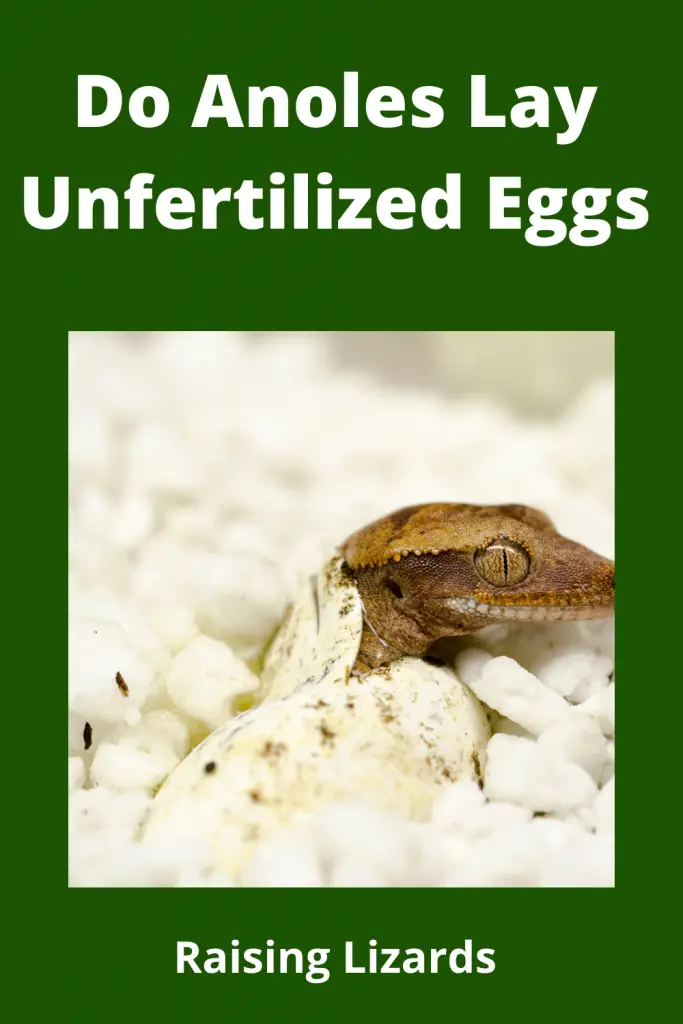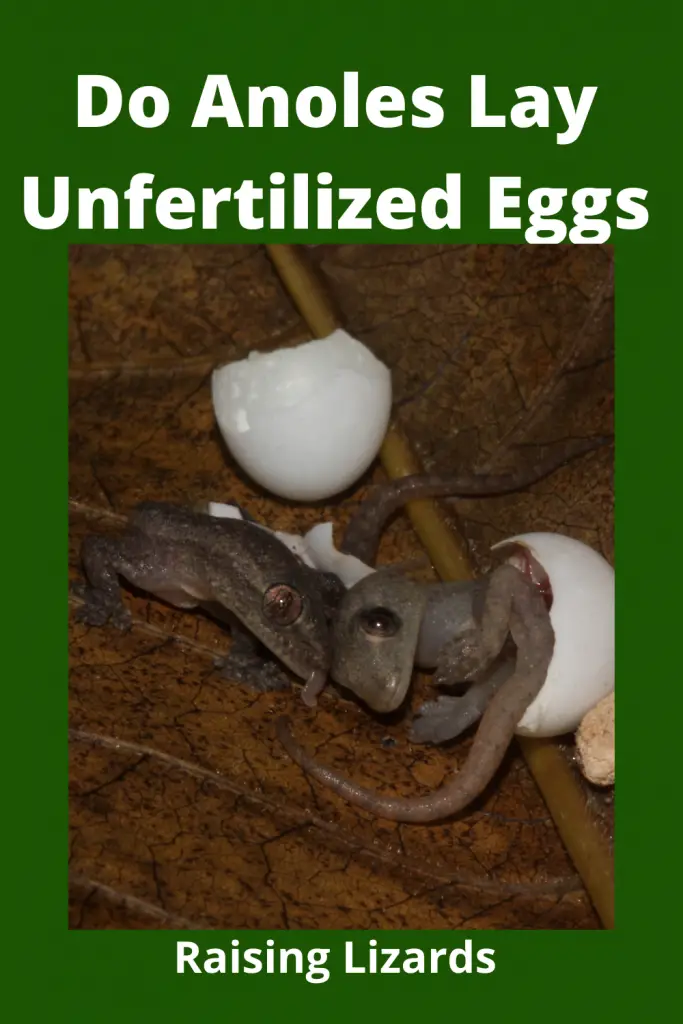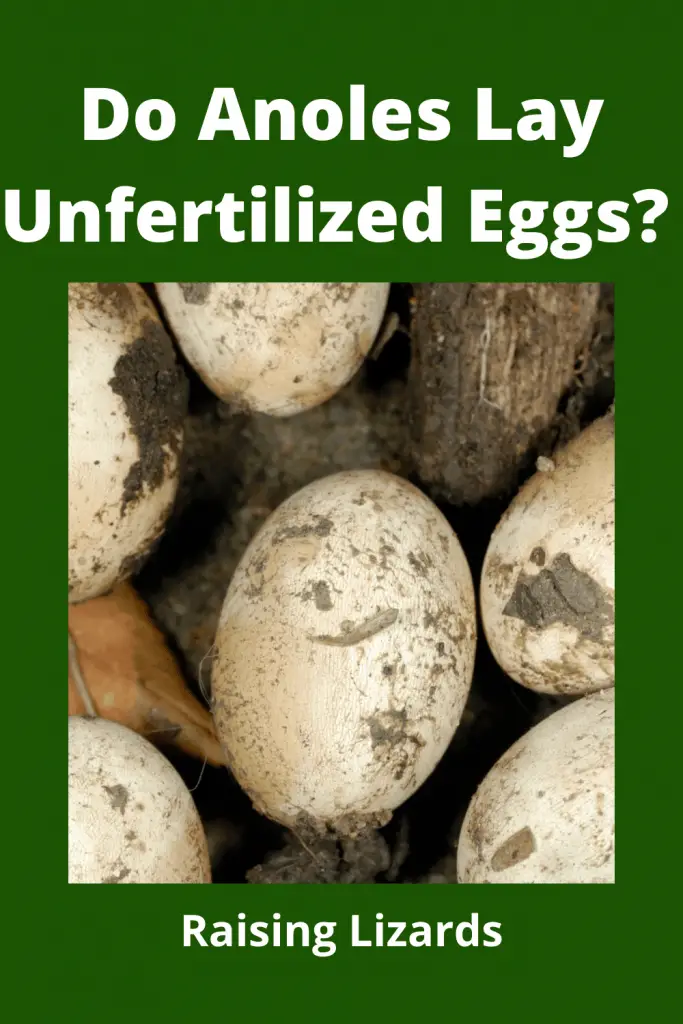As a General Rule for Anole eggs – Anoles lay their eggs. Anoles do not lay unfertilized eggs. is that when a male and female mate, the female stores the sperm in her body. If she doesn’t mate with another male in the breeding season, the stored sperm will fertilize her eggs. The female lays one egg and buries it in damp leaf litter, hollow logs, or moist soil. She usually lays one egg every two weeks during the breeding season. During the summer, she lays 15-18 eggs. The female does not live with the egg, nor does she care for the young, which will hatch in five to seven weeks.
Anole Eggs
Do Anoles Lay Unfertilized Eggs? The green anole, commonly known as the Carolina anole (Anolis carolinensis), is a small lizard usually kept as a pet. It is difficult for these reptiles to rear in captivity, not only because they are challenging to breed, but also it is not easy to keep hatchlings alive. Once the female anole lays eggs, her role is fulfilled. The baby’s anoles should survive on their own. Anole Eggs
The green anole breeding (Anole Eggs) lasts from March to September. The male will establish an area and patrol it. He will attract females by puffing out his gorgeous dewlap. The male anole performs a multiple series of visual exhibitions to develop a dominant atmosphere for females. It will push its head up and down, do “push-ups” and flare its dewlap to show strength. He will stretch his throat, puff his body out, and if he is in danger, he will turn to the threat and face it. He harmonizes with the female in his area and aggressively defends his area against other males.

Can Anoles Lay Unfertilized Eggs?
Anoles do not lay unfertilized eggs. is that when a male and female mate, the female stores the sperm in her body. If she doesn’t mate with another male in the breeding season, the stored sperm will fertilize her eggs. The female lays one egg and buries it in damp leaf litter, hollow logs, or moist soil. She usually lays one egg every two weeks during the breeding season. During the summer, she lays 15-18 eggs. The female does not live with the egg, nor does she care for the young, which will hatch in five to seven weeks.
The question we usually face is that owners want to breed their green anoles? They do not know how to do this? Or are they not sure eggs are fertilized or not? Their breeding ratio from male to female? Their bedding and environment? And their hatchability? Etc. We will discuss all these here to ease our viewers.
Relatively few breeders manage to breed green anoles to the second generation successfully. Green anoles are very challenging to mate, and females lay fertile eggs. Still, it can be challenging to keep hatchlings alive until they are old enough to care for themselves.
First, though, make sure you can legally maintain green anoles in your state. For example, Georgia has restrictive legislation on local reptiles. You may be amazed to learn that you are not allowed to keep them in the terrarium. Contact the Georgia Department of Natural Resources for details. You will need a permit to stay legally green anoles.
Okay, so now your green anole is legal, and you want to breed them. Change your cage first. The 20-gallon tank will hold several anoles, but it won’t give the male enough space to set up the area. You want a long terrarium which double the height of 20 gallons long. The terrarium can hold only a single male green anole lizard, which should be inhabited by many residents or artificial plants.

Plants serve two purposes: they allow green anole to form a separate area with boundaries, and they act as a base to spray clean water at least twice a day. Green Anoles lizards rarely drink from a water dish, but they often lick water droplets from the leaves. This is mainly important when trying to keep hatchlings alive. Relatively warm temperatures (80 degrees Fahrenheit), humid but well-ventilated conditions, and at least 12 hours of good light a day will help keep your anoles healthy.

Female to Male Ratio for Perfect Fertilized Eggs:
Finding a high place in the terrarium to serve as the center of his territory, a male green anole lizard can easily overcome the harem of four or five females. If this ratio disturbs, you may find difficulty in the hatchability of eggs because they can’t remain fertilized as one male is only enough for five females. If this number exceeds, you face a problem. Male
Perfect Mating Display of Male and Female for Successful Fertilization of Eggs:
Green Anole mating display includes nodding his head up and down and displaying his bright pink dewlap, which induces ovulation in mature females, including those that still carry sperm from the previous year.
Mating Procedure:
Adult females will be chased by a green anole that enters the male area, which will be caught with a healthy bite on the nape of the neck, and then reproduced for breeding. After mating, the female is released and may not be bred again. A pregnant female anole has enough to produce eggs in the summer and still has some sperm in the next breeding season. Before every egg is laid, the female has to be courted. She has to watch a male nodding his head and display a pink Dewlap.
Make sure a Well Damp Place for Egg Nesting is Available:
A mated female green anole lizard soon begins to produce small, round, white eggs with thick shells. Each ovary produces one egg. Eggs are usually placed in a coarse nest once laid in plant-based dirt or debris, making sure there must be a suitable place for the nest.

Each mating female lays one egg every ten days during the laying season, which hatches in summer and early fall. You can expect a dozen eggs from each female. Keep an eye on the newly laid eggs and remove some for incubation, leaving others for natural growth.
Humidity is Necessary for Hatching Fertilized Eggs:
Green anoles lizard eggs hatch in four to six weeks when the humidity is about 80% at 80 to 85 degrees. Hatchlings are smaller versions of parents, although they are usually gray and have relatively large heads and short tails.
The green anole is allowed to hatch in the terrarium, requiring access to small edible insects, such as baby crabs, spirits, or flying fruit flies. They should also have water in tiny droplets on the hints of leaves and other decorations. Babies hydrate quickly if the terrarium conditions are not right. They also face a fair amount of being killed by another hatchling, fighting when they meet or being eaten by adults. Some will probably survive as they grow.
Expose Newly Born Baby Anoles to Sunlight daily:
If you produce a baby’s green anole from the incubator, they should be kept separate (to prevent fighting) and be easy to keep moist and warm on a small enclosure. Try to expose the container to direct sunlight for at least three or four hours a day and make sure water droplets are on the box’s leaves or sides.
Most baby anoles don’t drink water when kept in small areas – even drop by drop. In such cases, first, hold the baby very carefully. Using an eyedropper, place a tiny drop of water on the tip of the baby anole snout so that it can lick the water. It is essential to repeat this several times a day until the baby starts drinking. Most captive green anoles die from dehydration, but many large groups are almost certain to survive and mature in just a few months.
Green Anole Eggs Structure:
Anole eggs are very tiny, measuring an average of 6 millimeters in length and 14 millimeters in circumference. The shell is white and may have splashed in shades of brown. Females green anoles typically lay one egg at a time, though they can lay a two-egg clutch in rare instances. When the female is fully ready to lay her egg, she tries to find moist soil to nestle it until it hatches.

Male and Female Behavior During Laying Season:
Males expend much energy in territorial defense, including aggressive signaling to neighboring males, patrol, and occasional chases or actual fights with intruders. Males lose bodyweight throughout the breeding season as they mate their females and defend them. Many males are displaced by other green anole males when fatigue sets in.
One study found a 76% turnover rate on protecting males during the 4-5 month breeding season. Breeding females are very inconspicuous. They only display rarely, and then it is when approached by a male or during the rare (about once/ 10 hours) aggressive encounter with a female neighbor. Females also limit their movements to almost a fifth that of males.
After the breeding season, both males and females act nearly the same because males stop patrolling and infrequently display while tripling their feeding rate to weight and energy reserves for the coming winter.


